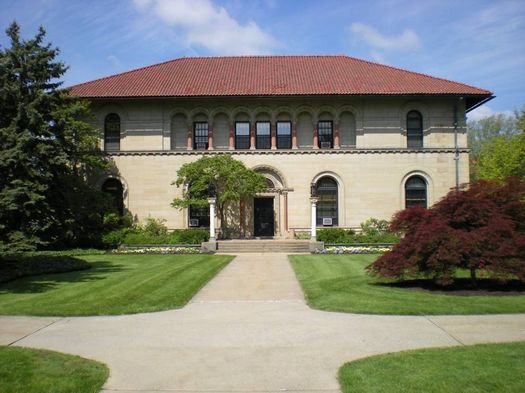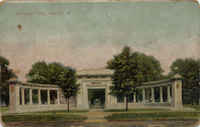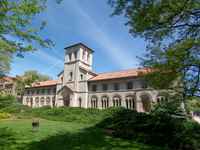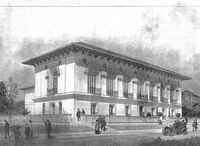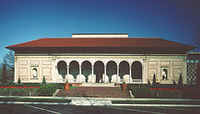Oberlin Cox Administration Building
- Other Names:
- Cox Building
- Location:
- 70 North Professor Street, Oberlin, Ohio
- Design & Construction:
- 1913-1915[1914-1915 Irish-1999 1913-1915 Christen-2001]
- Architect:
- Cass Gilbert
The Cox Administration Building, begun in 1913 and completed in 1915, was Gilbert's second structure on the Oberlin campus, and marked the turning point for Gilbert's influence on the college's campus design.
There had been two factions within the campus administration, one supporting Gilbert's vision for the campus and another in support of competing architect Joseph Lyman Silsbee's scheme. [Blodgett-1985 p 24] Chicago architect Joseph Lyman Silsbee (1848-1913) was senior to Gilbert, and had a longer history with the Oberlin campus. Silsbee designed the Memorial Arch (1903) and the Men's Building (now Wilder Hall, 1911). His campus plan would make the Memorial Arch the focal point and entry to the campus, with a north-south axis running from the arch though the center of Tappan Square. Tappan Square would be filled in with several campus buildings, centered on a large Administration Building featuring a pedestrian passageway through it.
On the other hand, many campus trustees and the Oberlin College President Henry Churchill King backed Gilbert's plan, which was inspired by and elaborated an earlier plan by the Olmsted Brothers of Boston, the sons of famous landscape architect Frederick Law Olmsted. The Gilbert-Olmsted campus plan, in sharp contrast to Silsbee's, called for the complete removal of all structures from Tappan Square, creating a central park at the heart of campus. The campus would be laid out with a highly formal structure of orthogonal lines; and buildings would all be constructed in one unifying Mediterranean-inspired style.
The selection of Gilbert as architect for the Cox Administration Building ended the debate and ushered in what is now referred to as the Cass Gilbert Era of the campus. [Blodgett-1985 p 25] It was named for Jacob Dobson Cox, one of Oberlin's famous graduates and notable as a Civil War general, holder of several political offices, and a university dean and president. The Cox Building is an exercise in restrained beauty. Round-arched windows are arranged in rhythmic regularity on the facades. The decorative wrought-iron grille above the entrance was fashioned by the noted Philadelphia artist Samuel Yellin. [Christen-2001 p 211] In the vestibule, two lunette-shaped murals were painted by Kenyon Cox, one of the sons of Jacob Cox. The symbols and allegory allude to his father and his mother, Helen Cox. [Christen-2001 p 211] The construction cost, including furniture and site, was $85,000. [Blodgett-1985 p 25]
See Also
-
Geoffrey Blodgett. "Oberlin College Architecture: A Short History." This online guide is an updated excerpt from his article which appeared in the Oberlin Alumni Magazine (May/June 1979). http://www.oberlin.edu/external/EOG/gbslides/AShortHistory.html
-
Geoffrey Blodgett. Oberlin Architecture, College and Town: A Guide to its Social History (Kent State University Press, Kent, Ohio, 1985). Blodgett's guide to the architecture of Oberlin College is the definitive work on the subject.
-
Oberlin College. Campus Photoguide: Jacob Dolson Cox Administration Building. http://www.oberlin.edu/archive/resources/photoguide/cox.html

